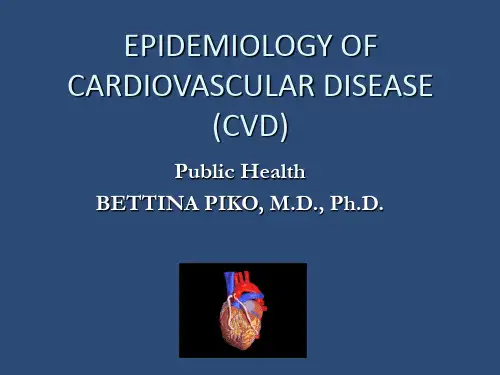- 1、下载文档前请自行甄别文档内容的完整性,平台不提供额外的编辑、内容补充、找答案等附加服务。
- 2、"仅部分预览"的文档,不可在线预览部分如存在完整性等问题,可反馈申请退款(可完整预览的文档不适用该条件!)。
- 3、如文档侵犯您的权益,请联系客服反馈,我们会尽快为您处理(人工客服工作时间:9:00-18:30)。
CVD made up 16.7 million of global deaths in 2002, among which 7 million due to coronary heart disease, 6 million due to stroke
Distribution of types of CVD in global deaths : Global cardiovascular deaths in 2002: 16.7 million among which: coronary heart disease 7.2 million
4,7பைடு நூலகம் 14,9% 24,6%
55,8%
>65 yrs
external others cancer CVD
PROPORTION OF MORTALITY IN DIFFERENT AGE-GROUPS (WOMEN)
100% 90% 80% 70% 60% 50% 40% 30% 20% 10% 0%
- Study of the natural history of CVD
- Formulation and testing of etiological hypotheses (risk factors)
- Contribution to the development of cardiovascular prevention programs and the measurement of their effectiveness
> stroke 6.0 million > 0.9 million hypertensive heart disease > 0.4 million inflammatory heart disease > 0.3 million rheumatic heart disease > 1.9 million other CVD
SDR: Standardized Death Rate
Direct mode of standardization, using the age distribution of a hypothetical European standard population
Premature death rates for comparison purposes (<64 years of age)
3., Experimental epidemiology/Interventions
= Strategies of cardiovascular prevention (primordial, primary, secondary, tertiary; individual and community levels)
Question: What is the relative amount of CVD in different geographical places? What are the time trends? International and regional characteristics of distribution
- Increase in CVD morbidity and mortality: in age-group of 30-44 years
- Premature death (<64 years of age, or 25-64 years): in the elderly population more difficult to interpret death rate due to multiple ill health causes
Public Health BETTINA PIKO, M.D., Ph.D.
- Leading cause of mortality in developed countries and a rising tendency in developing countries (disease of civilization)
1., Descriptive epidemiology:
= Describing distribution of cardiovascular disease by means of certain characteristics such as : PERSON (i.e., age, gender, ethnicity) TIME and PLACE
Developed countries: decreasing tendencies (e.g, USA: 30% between 1988-98, Sweden: 42%)
- improvement of lifestyle factors, for example, a decrease of smoking and a higher level of health consciousness in many developed countries
- Morbidity: nearly 30% of all disability cases
- Contributes to deterioration of the quality of life
- Coronary heart disease (CHD, ischemic heart disease, heart attack, myocardial infarction, angina pectoris)
- better diagnostic and therapeutic procedures (e.g., bypass surgeries, hypertension screening, pharmacological treatment of hypertension and hypercholesterinaemia, access to health care)
- In the US: increased cardiovascular disease deaths in African-American and South-Asian populations in comparison with Whites
- Increased stroke risk in African-American, some Hispanic American, Chinese, and Japanese populations
- A major impact on life expectancy
- Significantly contributes to morbidity and death rates in the middle aged population: potential life years lost, common cause of premature death, labor force (economic costs), family life
- Cerebrovascular disease (stroke, TIA, transient ischemic attack)
- Hypertensive heart disease
- Peripheral vascular disease
- Heart failure
- Rheumatic heart disease (streptococcal infection)
40,0%
35,0%
17,7% 7,3%
1-24 yrs
8,2% 24,0% 36,5%
31,3%
25-64 yrs
4,8% 18,3% 12,2%
64,7%
>65 yrs
external others cancer
CVD
Question: What is the relative amount of CVD in death rates in women and men?
- Migration: Ni-Hon-San Study: Japanese living in Japan had the lowest rates of CHD and cholesterol levels, those living in Hawaii had intermediate rates for both, those living in San Francisco had the highest rates for both
- Women: special case (WHO, 2004)
a., Higher risk in women than men (smoking, high triglyceride levels)
b., Higher prevalence of certain risk factors in women (diabetes mellitus, depression)
c., Gender-specific risk factors (risks for women only) (oral contraceptives, hormone replacement therapy, polycystic ovary syndrome)
Question: What is the relative amount of CVD in death rates in different ethnic groups?
Question: What is the relative amount of CVD in death rates in different age groups?
- Early lesions of blood vessel, atherosclerotic plaques: around 20 years - adult lifestyle patterns usually start in childhood and youth (smoking, dietary habits, sporting behavior, etc.)










